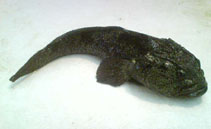
Notothenia [Parenotothenia] angustata
FAMILY
Nototheniidae
TAXONOMY
Notothenia angustata Hutton, 1875, Dunedin Harbour, New
Zealand.
OTHER COMMON NAMES
English: Black cod.
PHYSICAL CHARACTERISTICS
Grows to 2 ft (60 cm) in length. Mature specimens have a
massive body (length/depth ratio, 5:1) with a large, slightly
flattened head; heavy bony ridges over the eyes; and large
scales. The coloring is dark olive-gray to blue-black, with varying
light spots and lines; there are vague dark vertical bands on
the trunk. Juveniles are less flattened, with deeper bodies,
deard reddish bronze coloring, and prominent light spots.
DISTRIBUTION
Southern waters of New Zealand, from Stewart Island to
Kaikoura. It also is found in Chatham, Snares, Auckland, and
Campbell Islands and in Punta Arenas, Chile, and adjacent
water.
HABITAT
Adults are demersal on rocky bottoms, from near shore to 330
ft (100 m) depth. Juveniles are found in tide pools and among
kelp near the shore.
BEHAVIOR
Like most other notothenioids, the Maori chief is solitary and
never occurs in schools. Adults are shy and sedentary, foraging
among rocks and seaweed mainly at night. During the day,
they hide in crevices or under seaweed, occasionally lunging
for passing prey. Smaller fish are sucked into their mouth by
the sudden expansion of the jaws and opercula. Juveniles are
more active than adults, often leaving the bottom to forage in
the upper layers of kelp beds.
FEEDING ECOLOGY AND DIET
The Maori chief feeds on a wide range of bottom invertebrates,
crabs, and smaller fishes. Occasionally, it ingests seaweed.
REPRODUCTIVE BIOLOGY
The life cycle of the Maori chief is not well known. Eggs ripen
in November and presumably are deposited on the bottom. Juveniles
appear in rock pools in the summer (January) after an
incubation period of about 30 days and a brief pelagic dispersal
phase.
CONSERVATION STATUS
Not listed by the IUCN. This species was caught for the local
market up to the 1950s, when stocks were reported to be overfished.
There is currently no commercial fishery for this
species, nor has it been assigned a quota under New Zealand’s
quota management system.
SIGNIFICANCE TO HUMANS
This is said to be a palatable species, but its fearsome appearance
and coarse texture relegate its use mainly to bait in lobster
pots.
Other popular Animals
Photo Gallery of - Maori chief fish





 Animalia Life
Animalia Life